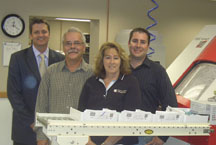By Bill Scott
VP/Optical Retail Group Publisher
 |
| At Cherry Optical in Green Bay, Wisconsin are, left to right, Kurt Atchison of Schneider Optical Machinery, Joe Cherry, Lynn Cherry and Adam Cherry. At right is the lab’s new Schneider HSC Smart A generator. |
GREEN BAY, Wis.—Like most independent optical laboratories, Cherry Optical has been grappling with a major decision—whether or not to invest in digital surfacing equipment that would allow them to manufacture the most advanced lens designs in-house. This summer, the lab made its move, installing Schneider equipment in its Green Bay, Wisconsin facility.
“Cherry is a small family-owned business and cannot compete with the ‘big guys’ on price and marketing. But we can compete in the technology area,” said founder and president Joe Cherry, a veteran lab executive who manages the company with his son, Adam.
Cherry said the leap into the digital surfacing arena is significant not only because it represents a technological advance for the lab, but because it establishes Cherry Optical as a full-service lab. Since Cherry and his wife Lynn founded the lab in 1999, it has provided only lens finishing services. Surfacing jobs had to be outsourced. When Cherry Optical began digital surfacing on Aug. 15, the amount of outsourcing was immediately reduced.
Cherry said the lab is using its enhanced surfacing capabilities to offer its accounts new products.
“The technology enables us to turn eyewear into jewelry, as well as do wraps,” remarked Cherry. Although some labs use digital surfacing to produce only progressive lenses, Cherry said his lab will use the technology to produce other lens designs as well. “Digital has been hijacked by progressives,” he said. “It has many more uses beyond just progressives.”
Going digital was the result of an 18-month process during which Adam Cherry evaluated machinery from different vendors. He settled on three pieces of equipment from Schneider Optical Machines: the CB Bond blocker, HSC Smart A generator and CCP Swift polisher.
“We liked their approach to service, equipment problem resolution, cost and technology,” said Adam Cherry. “Many of the major lens manufacturers are running Schneider equipment,” he noted. “It seemed to me to be more proven, field tested technology.”
Before making a purchase decision, Cherry Optical’s lab supervisor, John DeGref, visited another Schneider-equipped lab and spent a few days familiarizing himself with the equipment.
The Cherry team conducted a financial analysis with the lab’s accountant so they understood all costs involved with the conversion, including equipment, labor costs, space allocation and consumables. This exercise not only helped them analyze their options in terms of whose equipment to buy but has also created a template for their annual company budget. According to Joe Cherry, the equipment was profitable “from lens one,” and he expects a four to four-and-a-half-year payback on the equipment at current volume levels.
■ —With contributions from Andrew Karp